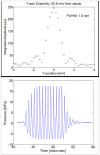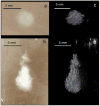Acoustic droplet vaporization for enhancement of thermal ablation by high intensity focused ultrasound
- PMID: 21703883
- PMCID: PMC3152672
- DOI: 10.1016/j.acra.2011.04.012
Acoustic droplet vaporization for enhancement of thermal ablation by high intensity focused ultrasound
Abstract
Rationale and objectives: Acoustic droplet vaporization (ADV) shows promise for spatial control and acceleration of thermal lesion production. The investigators hypothesized that microbubbles generated by ADV could enhance high-intensity focused ultrasound (HIFU) thermal ablation by controlling and increasing local energy absorption.
Materials and methods: Thermal lesions were produced in tissue-mimicking phantoms using focused ultrasound (1.44 MHz) with a focal intensity of 4000 W · cm(-2) in degassed water at 37°C. The average lesion volume was measured by visible change in optical opacity and by T2-weighted magnetic resonance imaging. In addition, in vivo HIFU lesions were generated in a canine liver before and after an intravenous injection of droplets with a similar acoustic setup.
Results: Thermal lesions were sevenfold larger in phantoms containing droplets (3 × 10(5) droplets/mL) compared to phantoms without droplets. The mean lesion volume with a 2-second HIFU exposure in droplet-containing phantoms was comparable to that made by a 5-second exposure in phantoms without droplets. In the in vivo study, the average lesion volumes without and with droplets were 0.017 ± 0.006 cm(3) (n = 4; 5-second exposure) and 0.265 ± 0.005 cm(3) (n = 3; 5-second exposure), respectively, a factor of 15 difference. The shape of ADV bubbles imaged with B-mode ultrasound was very similar to the actual lesion shape as measured optically and by magnetic resonance imaging.
Conclusion: ADV bubbles may facilitate clinical HIFU ablation by reducing treatment time or requisite in situ total acoustic power and provide ultrasonic imaging feedback of the thermal therapy.
Copyright © 2011 AUR. Published by Elsevier Inc. All rights reserved.
Figures








Similar articles
-
The effects on thermal lesion shape and size from bubble clouds produced by acoustic droplet vaporization.Biomed Eng Online. 2018 Oct 29;17(1):163. doi: 10.1186/s12938-018-0596-z. Biomed Eng Online. 2018. PMID: 30373677 Free PMC article.
-
Acoustic Droplet Vaporization for the Enhancement of Ultrasound Thermal Therapy.Proc IEEE Ultrason Symp. 2010 Oct 11;2010:221-224. doi: 10.1109/ULTSYM.2010.0054. Proc IEEE Ultrason Symp. 2010. PMID: 21804749 Free PMC article.
-
Acceleration of ultrasound thermal therapy by patterned acoustic droplet vaporization.J Acoust Soc Am. 2014 Jan;135(1):537-44. doi: 10.1121/1.4828832. J Acoust Soc Am. 2014. PMID: 24437794 Free PMC article.
-
Numerical Study of Bubble Cloud and Thermal Lesion Evolution During Acoustic Droplet Vaporization Enhanced HIFU Treatment.J Biomech Eng. 2022 Mar 1;144(3):031007. doi: 10.1115/1.4052374. J Biomech Eng. 2022. PMID: 34505142
-
Acoustic droplet vaporization in biology and medicine.Biomed Res Int. 2013;2013:404361. doi: 10.1155/2013/404361. Epub 2013 Nov 20. Biomed Res Int. 2013. PMID: 24350267 Free PMC article. Review.
Cited by
-
Impact of Perfluoropentane Microdroplets Diameter and Concentration on Acoustic Droplet Vaporization Transition Efficiency and Oxygen Scavenging.Pharmaceutics. 2022 Nov 5;14(11):2392. doi: 10.3390/pharmaceutics14112392. Pharmaceutics. 2022. PMID: 36365210 Free PMC article.
-
Spatial specificity and sensitivity of passive cavitation imaging for monitoring high-intensity focused ultrasound thermal ablation in ex vivo bovine liver.Proc Meet Acoust. 2013 Jun 2;19(1):075022. doi: 10.1121/1.4800327. Proc Meet Acoust. 2013. PMID: 24817990 Free PMC article.
-
Assessment of the biodistribution of an [(18) F]FDG-loaded perfluorocarbon double emulsion using dynamic micro-PET in rats.Contrast Media Mol Imaging. 2013 Jul-Aug;8(4):366-74. doi: 10.1002/cmmi.1532. Contrast Media Mol Imaging. 2013. PMID: 23613440 Free PMC article.
-
Phase-transition thresholds and vaporization phenomena for ultrasound phase-change nanoemulsions assessed via high-speed optical microscopy.Phys Med Biol. 2013 Jul 7;58(13):4513-34. doi: 10.1088/0031-9155/58/13/4513. Epub 2013 Jun 13. Phys Med Biol. 2013. PMID: 23760161 Free PMC article.
-
Acoustic Cavitation Enhances Focused Ultrasound Ablation with Phase-Shift Inorganic Perfluorohexane Nanoemulsions: An In Vitro Study Using a Clinical Device.Biomed Res Int. 2016;2016:7936902. doi: 10.1155/2016/7936902. Epub 2016 Jun 23. Biomed Res Int. 2016. PMID: 27419138 Free PMC article.
References
-
- Boyle P, Levin B, editors. World Cancer Report 2008. Lyon, France: IARC Press; 2008. p. 350.
-
- Yamasaki S, Hasegawa H, Makuuchi M, Takayama T, Kosuge T, Shimada K. Choice of treatments for small hepatocellular carcinoma: hepatectomy, embolization or ethanol injection. J Gastroenterol Hepatol. 1991;6(4):408–13. - PubMed
-
- Molinari M, Helton S. Hepatic resection versus radiofrequency ablation for hepatocellular carcinoma in cirrhotic individuals not candidates for liver transplantation: a Markov model decision analysis. Am J Surg. 2009;198(3):396–406. - PubMed
-
- Cancer Facts and Figures. American Cancer Society; 2004.
-
- Hill CR, ter Haar GR. Review article: high intensity focused ultrasound--potential for cancer treatment. Br J Radiol. 1995;68(816):1296–303. - PubMed
Publication types
MeSH terms
Substances
Grants and funding
LinkOut - more resources
Full Text Sources
Other Literature Sources

